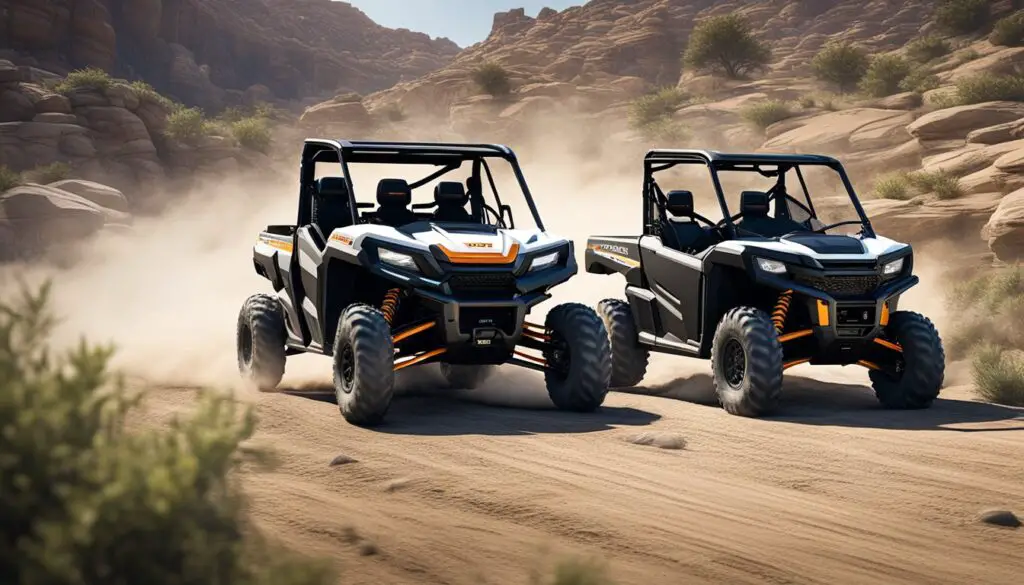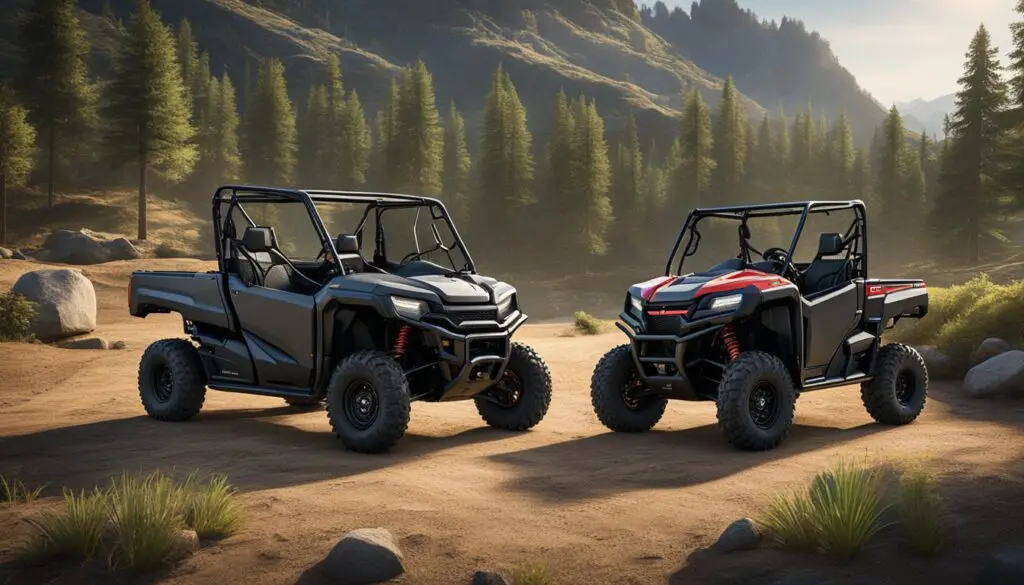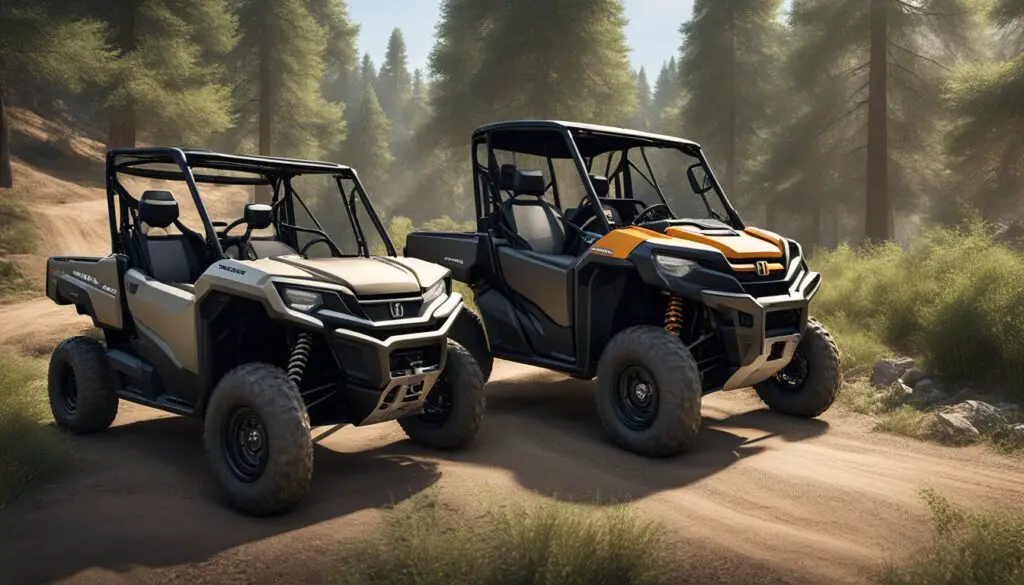In the world of utility terrain vehicles (UTVs), a good side-by-side can be your best ally out in the field, whether you’re tackling the rugged trails or managing farmland chores. Your choice often comes down to balancing reliability, power, and cost, and two contenders stand out in this category: the Honda Pioneer 520 and the Polaris Ranger 500. Each has its strengths, with the Pioneer known for Honda’s reputable reliability, and the Ranger noted for its efficient power delivery.

When considering the Honda Pi oneer 520, you’re looking at a machine with a modest bump in power over its predecessor, the Pioneer 500. It offers a power-assisted dump bed and has options that can tailor the vehicle to your specific needs. On the other side, the Polaris Ranger 500 is appreciated for being a hardworking and smoothly operated ride, with a power output that enthusiasts say efficiently transfers power to the wheels. This could be a key factor in making your decision if you prioritize a vehicle’s ability to handle heavy loads with ease.
The price point is often the ultimate decider, and it’s important to note that both models are competitively priced, each hovering around that just-under-$10,000 mark. But beyond the price, you’ll likely consider the subtle differences in features, customization options, and the feel of the ride that each brand brings to the table. This comparison could be exactly what you need to determine which side-by-side will earn its place in your garage.
Overview of UTV Market
In your search for the perfect off-road companion, you’ll notice that the utility task vehicle (UTV) market, also known as side-by-side market, offers a variety of options tailored to both work and play needs. On one end, you find models engineered for heavy-duty tasks, and on the other, vehicles designed for high-speed off-roading fun.
Key Players: You’ll likely come across big names in the industry, Honda and Polaris being among them. Their models, like the Honda Pioneer 520 and Polaris Ranger 500, cater to differing preferences and requirements.
- Honda Pioneer 520: Renowned for its reliability and enhanced features such as increased pulling power.
- Polaris Ranger 500: Favored for its working capabilities and reportedly smoother ride.
Market Trends: The market tends to shift towards UTVs with more power and customized options, making side-by-sides not just a utility tool, but a lifestyle choice.
| Feature | Honda Pioneer 520 | Polaris Ranger 500 |
|---|---|---|
| Reliability | High | Moderate |
| Power | Less compared to Ranger 500 | Standard |
| Customization | Available | Available |
| Riding Comfort | Standard | Smooth |
Usage: Your intended use is a driving factor in the market. Whether it’s for agricultural work, trail exploration, or a mix of both, the UTV market has variations to suit your specific goals.
Remember, the best UTV for you balances power, reliability, customization, and comfort to match your adventures or work demands.
Comparing Honda Pioneer 520 vs Polaris Ranger 500
When you’re deciding between the Honda Pioneer 520 and the Polaris Ranger 500, there’s a lot to consider from heritage and engine performance to utility features and pricing. Each section below sheds light on these aspects to help you make an informed decision.
Brand Heritage
Honda is known for its durable and reliable vehicles, with a long history in both automotive and powersports industries. The Pioneer 520 carries this legacy. Polaris has a reputation for innovative and versatile off-road vehicles, and the Ranger 500 is a popular choice among enthusiasts for its robust performance.
Engine and Performance
The Pioneer 520 is equipped with a 518cc engine, while the Ranger 500 features a Prostar 500cc engine. While performance can vary, you might expect more torque from Honda’s slightly larger engine.
Drivetrain and Transmission
Honda’s model typically features a sophisticated drivetrain with a dual-clutch transmission that offers a manual-shifting experience via paddle shifters. The Ranger 500 often includes a CVT (Continuous Variable Transmission), which can provide a more seamless power delivery.
Towing and Payload Capacities
Both models are capable, but they may differ in their maximum tow and payload ratings. Polaris vehicles sometimes have the edge in raw towing capacity.
Dimension and Weight
Choices may differ slightly in length, width, height, and wheelbase, which in turn can affect stability and storage.
Suspension and Handling
Front and rear suspension systems are crucial for a smooth ride. Both brands offer models with independent suspensions, but differences in shock absorbers and control systems can influence steering and handling.
Utility and Storage Features
Look at the bed capacity and storage options on each model. This varies, affecting the vehicle’s usefulness for work-related tasks.
Comfort and Seating Arrangements
Seat design and the availability of cab options can impact comfort during long rides. The Pioneer 520 generally offers bench or bucket seats, whereas Ranger 500 configurations can vary.
Design and Aesthetics
The aesthetic appeal can be subjective. However, design features like the roll cage, frame, and overall ergonomics are part of each brand’s style.
Tire and Brake Specifications
Both the Pioneer 520 and the Ranger 500 equip hydraulic disc brakes, with different tire sizes that affect traction and control.
Pricing and Value for Money
The MSRP might reflect what you get in terms of features and capabilities. Off-road vehicles are an investment, so comparing the cost to the specifications is crucial.
Pros and Cons
Listing advantages and disadvantages can clarify which vehicle suits your needs. Consider aspects like power, comfort, and terrain compatibility.
Reliability and Maintenance
Honda often holds an edge in reliability; maintenance for both brands will include engine, drivetrain, and CVT belt servicing.
Options and Variants
Each model might come with different trim levels or options, such as the Pioneer 1000 or Ranger 1000, to cater to varied preferences.
Safety and Security Features
Safety is paramount. Both vehicles possess safety features like sturdy frames and possibly additional security features depending on the model.
Fuel Economy and Capacity
Fuel capacity is important for ranging far, and efficiency can dictate how often you’ll need to refuel. Check each model’s specifications for exact numbers.
Off-road Capabilities and Recreation
Both vehicles are designed with off-roading in mind. However, ground clearance and suspension play significant roles in off-road performance.
Specifications Comparison
Comparing specs side by side can illustrate differences in power, size, and capabilities that may not be apparent at first glance.
Market Trends and Consumer Preferences
Understanding what other consumers value can provide insight into which model might best suit market demands and individual needs.
Detailed Comparison

Before you decide on your off-road partner, let’s compare specifics about the Honda Pioneer 520 and Polaris Ranger 500. You’ll get to know the engine performance, hauling capabilities, comfort levels, and more.
Engine Specifications
The Honda Pioneer 520 is powered by a 475cc liquid-cooled single-cylinder four-stroke engine. It offers 29 horsepower with a fuel-injected system making for smooth performance. The Polaris Ranger 500, on the other hand, comes with a 500cc ProStar engine that outputs slightly less power at 32 horsepower.
Transmission and Driveline
Both the Pioneer 520 and Ranger 500 use automatic transmissions, but the Honda features a five-speed automatic with an automatic clutch and a manual mode, whereas the Polaris sports a Continuously Variable Transmission (CVT) for ease of use. Each vehicle supports a 2WD/4WD driveline with a differential lock to handle tough terrains.
Towing and Payload
The Pioneer 520 boasts a towing capacity of up to 1000 pounds and a payload capacity of 450 pounds in the dumping cargo bed. The Ranger 500 edges forward with a slightly higher towing capacity of 1500 pounds and a payload of around 900 pounds.
Dimensions and Capacities
Your Honda Pioneer 520 sits with a length of 107.7 inches, a width of 50 inches, and a height of 71.5 inches. The Polaris Ranger 500 is bigger in size with a length of 110 inches, width of 58 inches, and height of 73 inches, which might impact where you can store and ride.
Suspension and Comfort
For suspension, the Pioneer 520 has an independent dual-arm setup both at the front and rear, which should give you a comfortable ride. Polaris Ranger 500 offers independent suspension as well, ensuring that it can take on rough trails with ease.
Utility and Function
The Honda provides a manual dump bed for utility tasks, and the Polaris follows up with a power-assisted dump bed, adding a bit of ease to your chores. Both UTVs come with an array of accessory options for customization, ensuring you can tailor them to your needs.
Ride and Handling
With its tighter 50-inch width, the Pioneer might be nimbler in narrow trails, whereas the Ranger 500 could provide a more stable ride due to its wider stance. The choice will depend on the terrains you prefer to conquer.
Pricing and Affordability
When it comes to hitting the pocketbook, the Pioneer 520 has a starting MSRP of $9,499, while the Ranger 500 begins at $9,699. This puts them fairly close in terms of initial investment, with the final decision possibly coming down to brand preference and the specific needs of their utility.
Frequently Asked Questions

When comparing the Honda Pioneer 520 and the Polaris Ranger 500, it’s essential to consider various aspects that matter to you as a rider. The following FAQs provide insights tailored to these specific models.
What are the main differences in specifications between the Honda Pioneer 520 and the Polaris Ranger 500?
The Honda Pioneer 520 is known for its reliability and features a 518cc engine. The Polaris Ranger 500 has a 500cc engine. The Pioneer 520 offers a slight edge in engine displacement that might affect performance and towing capabilities.
Which has better performance: the Honda Pioneer 520 or the Polaris Ranger 500?
While the Polaris Ranger 500 is recognized for its 32 HP engine that provides smooth riding and useful features like on-demand 4WD, the Honda Pioneer 520 with its slightly larger engine may offer increased pulling power, which translates into better performance in certain conditions.
Can someone compare the handling and off-road capabilities of the Honda Pioneer 520 and the Polaris Ranger 500?
The Polaris Ranger 500 is praised for its user-friendly handling and effective 4WD making it versatile for off-road conditions. On the other hand, the Honda Pioneer 520 is designed with a focus on utility and durability, which may influence its handling and off-road capabilities positively.
Which is more reliable, the Honda Pioneer or the Polaris Ranger, based on user reviews and forums?
According to user reviews and forums, the Honda Pioneer series is often lauded for its long-term reliability, which could make the Honda Pioneer 520 a strong contender. The Polaris Ranger series also has a solid reputation but may vary on a model-by-model basis.
Between the Honda Pioneer 520 and the Polaris Ranger 500, which offers more value for its price?
Both vehicles have similar starting price points, but the Honda Pioneer 520 might come out ahead in value with its increased engine size and Honda’s reputation for reliability. The decision on value, however, will largely depend on individual needs and preferences concerning utility and performance.
Are there any notable differences in maintenance and upkeep costs between the Honda Pioneer 520 and the Polaris Ranger 500?
Neither model stands out as significantly more expensive to maintain than the other. However, Honda generally has a strong reputation for lower maintenance needs due to its build quality. Polaris models can be more performance-oriented, potentially influencing maintenance costs differently.

Leave a Reply